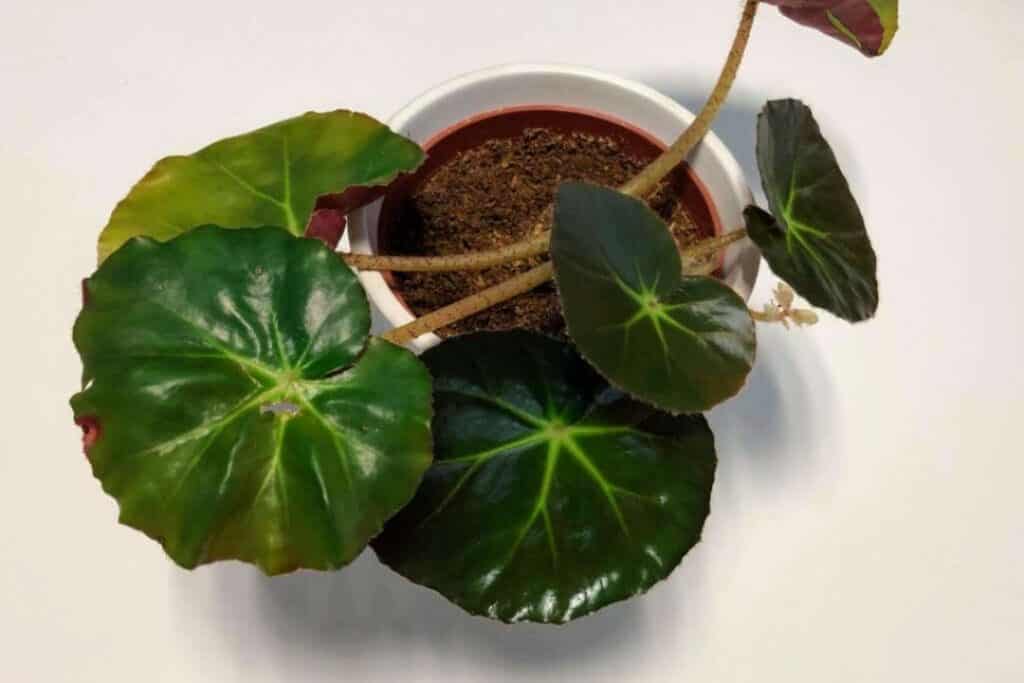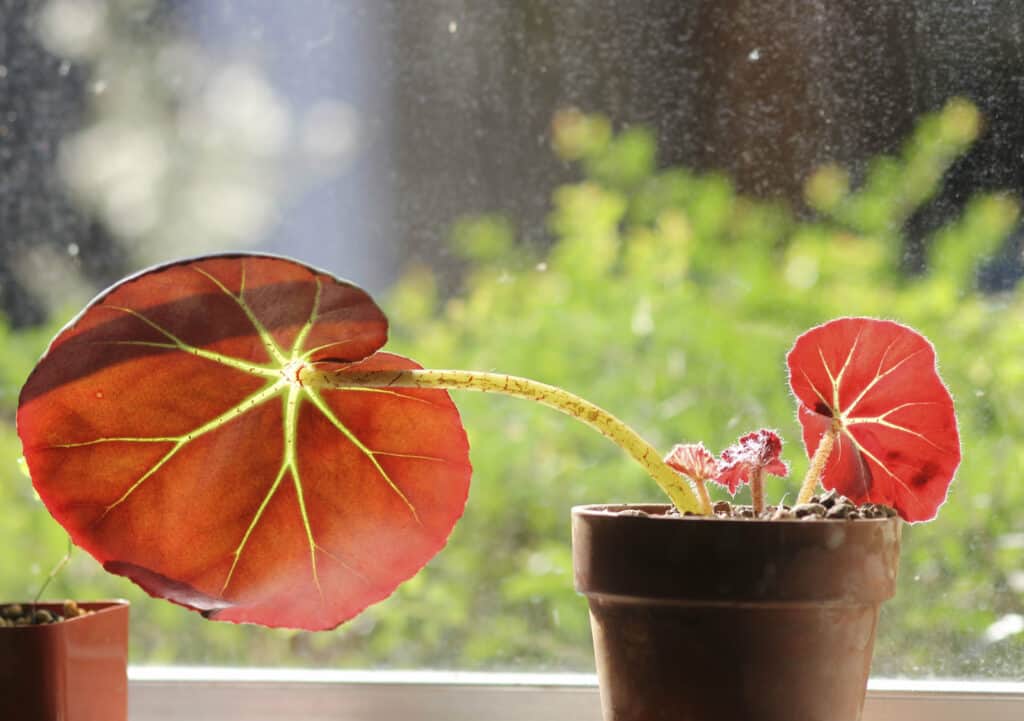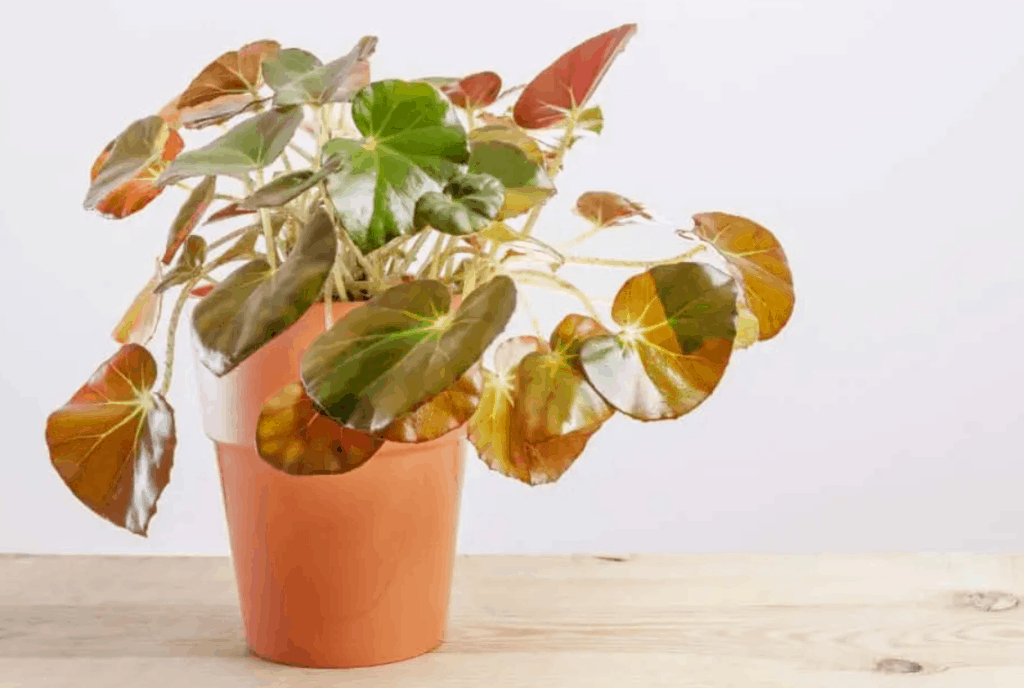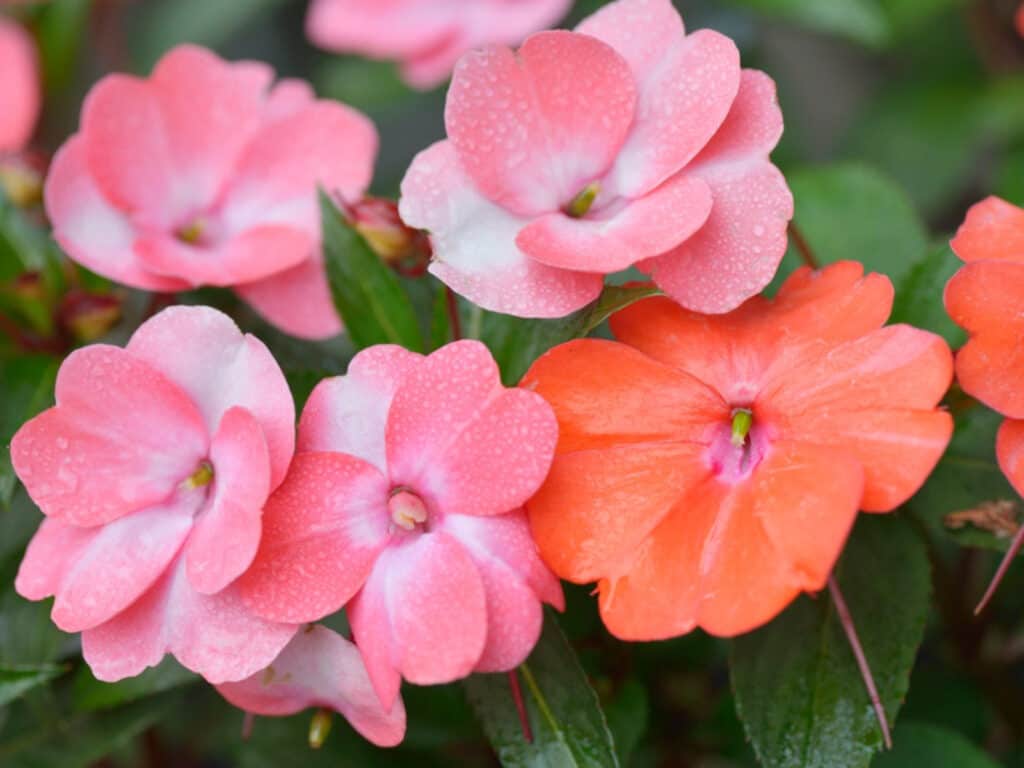- Strawberry Begonia: When Is The Perfect Time To Propagate It? - August 15, 2021
- Beefsteak Begonia: Everything You Need To Know About It - August 12, 2021
- Ficus Altissima: How To Identify This Plant From The Ficus Family? - August 2, 2021
Are you looking for an easy way to add attention-grabbing foliage to your home? An indoor tree might sound too committal, but a tiny succulent won’t do the trick. Enter, the coveted Beefsteak Begonia.
Showcasing muted hues of crimson red and forest green, this hardy houseplant might start out small, but it can easily overfill a pot with the proper care. Today, we’re sharing everything you need to know about this trailing beauty.
How to Identify Beefsteak Begonia
The scientific name for Beefsteak Begonia is Begonia x erythrophylla. One of the first hybrid begonias, it was developed in Germany back in 1845. If you’re seeking this particular variety among all of the other types of begonias, then it helps to know some of its distinguishing characteristics.
In general, there are three different types of begonias. They include:
- Fibrous rooted
- Rhizomatous rooted
- Tuberous rooted
Beefsteak Begonias fall into the Rhizomatous rooted category. A rhizome is an underground stem that grows horizontally, sending up lateral shoots at various intervals.
This plant features large, slightly oblong leaves, offset by small pink and white flowers that pop up in the winter and smell surprisingly sweet. The stems on this plant are also slender and long. Its leaves can be dark green or deep red and will trail outside of any container if given the opportunity. At full maturity, this plant can grow to about 18 to 20 inches in height!
That pop of red is what gives this plant its unique name. Its color scheme mimics that of a well-aged steak! It also goes by a few other names including Swamp Lily Begonia, Pond Lily Begonia, and even Kidney Begonia!
While Beefsteak Begonias aren’t found as often in nurseries, they’re easy to grow from cuttings. You may have even inherited one from a relative, as these are some of the longest-growing begonia varieties around.
How to Grow Beefsteak Begonia From Seed

While it would be ideal to grow a Beefsteak Begonia from seed, this simply isn’t possible under normal conditions. Why is that the case? Though the plant’s scented pink flowers are beautiful to look at, they are sterile. That means that they do not produce seeds.
How to Propagate Beefsteak Begonia
Don’t fret for too long that you can’t grow a Beefsteak Begonia from seed! As long as you know the right methods to use, you can easily propagate this plant species and share it with others who want to enjoy its beauty. For this reason, many plant parents choose to share cuttings of their begonias. It’s even common to see Beefsteak Begonias passed down from generation to generation!
One of the most common methods is the Stem Cutting Method. To propagate your plant this way, use a sharp, sterile knife to cut a growing stem back by around five to seven inches. If possible, make the cut right below a leaf node.
With the cutting in hand, find the lowest leaf. Slice it off and place the cutting in a cup of clean water. You’ll have to be patient, but you should begin to see roots develop in around one to two weeks. This is one of the easiest, quickest, and most effective ways to propagate a Beefsteak Begonia. Plus, it gives you a good reason to give yours a good trim every once in a while!
If you want to try a slightly more advanced method, then you may want to consider Rhizome Cutting. As mentioned, rhizomes are subterranean stems that use nodes to grow roots. In addition, they can also catalyze stem growth. Using sharp and sterile shears, clip off a healthy rhizome. Then, place it in a container of clean potting soil and look for signs of new growth!
As you conduct more research into propagating Beefsteak Begonia, you’ll soon hear stories of people propagating their plants using nothing more than leaf-cutting! This is the most advanced technology on our list but it isn’t impossible. If you’re ready to try, here are the steps in order:
- Use a sharp, sterile knife to cut a leaf from your Beefsteak Begonia.
- Prepare a solution of water and rooting hormone.
- Place the plant leaf in the water mixture.
- Watch for signs of new growth, which should occur in about two weeks.
With all of these three methods, you can re-pot the plant once it begins to grow again and develops a solid amount of roots. Transplanting it too early could stress your plant and inflict unnecessary damage.
Beefsteak Begonia Growing Conditions

While you can plant a Beefsteak Begonia outdoors in certain conditions, this species works best as an indoor houseplant. As long as the temperature and humidity in your home remain consistent, you can enjoy taking care of yours for years to come!
If you live in USDA Hardiness Zones 9 through 11, then your outdoor climate should be temperate enough to successfully grow your plant outdoors all year. However, if you live in any other zone, be sure to bring your Beefsteak Begonia inside as soon as cool weather hits.
Ideally, try to keep your Beefsteak Begonia in an environment that stays consistently between 65 and 75 degrees Fahrenheit. If you need to go a little higher, it can tolerate temperatures up to 85 degrees. However, don’t go any lower. It can start to wilt and become weakened if temperatures dip below 60 degrees.
The best humidity level for your begonia is anywhere between 60% and 80% humidity. The only issue? Most homes hover around 30% to 50%. To put a little more moisture into your air, consider running a humidifier. You can also spritz the plant periodically, although allowing water to stand on its leaves could lead to mildew and fungus.
Another alternative is to place your planter in the most humid room of your home: the bathroom! If none of these ideas work, then you can always place the planter on a shallow tray filled with a small amount of water and some small pebbles. The water will evaporate throughout the day and naturally increase the humidity in your home.
One last condition to keep in mind? This begonia variety prefers to be fairly root-bound. While many gardeners might balk at the idea of letting a plant essentially outgrow its container, this just means that you’ll need to trim it back every so often. This way, you can maintain its shape and optimize the plant’s opportunity for survival.
Next, let’s take a closer look at how you can set the stage for continued growth and help your Beefsteak Begonia thrive.
How to Plant Beefsteak Begonia
There are specific conditions that your plant needs to experience to grow to its optimal height. Let’s briefly review how to get these key points right.
Beefsteak Begonia Potting & Soil
Beefsteak Begonias are acclimated to tropical conditions and grow best in soil that is quick-draining and slightly acidic. The soil should also be loose and airy so oxygen can flow through it as easily as possible. This way, the plant can breathe and grow!
When browsing the different varieties of potting mixes at the store, take the acidity level of each one into consideration. Opt for ones that are a little acidic or neutral, with an advertised pH level of 6.1 to 7.5. In general, potting soil that’s marketed for African violets will work well for Beefsteak Begonias, as the two plants require very similar growing conditions.
If you don’t want to go out and buy an entirely new package of potting soil, we’ve got you covered!
You can amend standard potting soil and improve its drainage by adding a few ingredients that will break it up and make it less dense, such as:
- Aged compost
- Peat moss
- Perlite
- Pumice
- Vermiculite
Beefsteak Begonia Water Requirements

Beefsteak Begonias love to stay consistently moist, but they don’t like standing on wet feet. Leaving their soil too soggy could make them susceptible to a damaging condition known as root rot.
Why is this issue especially prominent with this variety of begonia? As we mentioned, Beefsteak Begonias are rhizomatous plants. Its rhizomes store water just as the leaves on a succulent would do. As such, while it’s important to water your plant regularly, be sure to exercise caution.
To gauge if yours is ready to drink again, stick your finger about one to two inches into the top of the soil. If that part feels dry, then it’s watering time! Otherwise, leave it be and check again later one or two days later.
While it’s important to understand watering frequency, it’s equally critical to know how to water your Beefsteak Begonia. Water it low and close to its roots, slowly pouring water onto the soil until you’re confident that you’ve thoroughly soaked the entire root ball.
Simply pouring water on the plant could mean giving its leaves a nice shower, but could leave your roots begging for moisture. At the same time, getting the leaves wet could lead to a fungal leaf infection, especially if your plant takes a while to dry off.
Beefsteak Begonia Light Requirements
Beefsteak Begonias are hardy and will do well under most lighting conditions. However, they do best when exposed to bright, indirect light, or partial shade. Try to keep it away from direct sunlight, as the heat could scorch its delicate leaves.
If you decide to grow yours outdoors, then look for an area that gets plenty of suns but isn’t directly exposed to it, especially in the middle of the afternoon. If you can find a spot under a little shade, then that’s perfect! You can get the shade from overhead trees or even the shadows cast by the angles of your home. If no area exists, you can even set up a canopy to replicate that environment.
If you’re keeping your plant indoors, then seek out a north-facing window if possible. That way, the morning sun won’t be too harsh. Whatever you do, resist the urge to place your plant right beside a window, allowing a few feet of space to shield it.
Best Beefsteak Begonia Fertilizer
When it comes to fertilizer, you don’t have to get too fancy with your Beefsteak Begonia. Any liquid houseplant fertilizer will do, though you’ll need to dilute it to 50% strength. Apply the fertilizer every two to four weeks during the plant’s peak growing season in the summer. You can gradually cut back when temperatures get cool and stop altogether in the winter.
Generally, begonias are very tolerable to fertilizer, as they’re heavy feeders. However, too much of a good thing can backfire. Over-fertilizing your Beefsteak Begonia could burn its roots. To avoid this issue, start with a small amount and monitor your plant’s growth. If you want to see it thrive a little more, then you can slowly add more fertilizer until you’ve achieved the desired effect.
Best Beefsteak Begonia Companion Plantings

Are you planning to incorporate Beefsteak Begonias into your outdoor landscaping? While these can make a gorgeous impression in a standalone planter, they also look beautiful alongside other companion plantings.
The following plants grow particularly well with begonias and feature bold hues that will offset the plant’s red and green tones:
- Impatiens
- Caladium
- Boston fern
- Coleus
- Hostas
- Bergonias
If you add a few Beefsteak Begonias to an outdoor planter, then consider adorning the surrounding space with annuals, such as alyssum or lobelia. These cascading plants will cover the ground around the begonia and add a ton of visual appeal.
Beefsteak Begonia Diseases and Common Problems
Beefsteak Begonias may be attractive to look at, but that doesn’t mean that they’re immune to pests, diseases, and other common plant problems. If you know what to expect from your plant, then you can take proactive measures to keep it as healthy as possible.
The most common diseases that plague this type of begonia include:
- Powdery mildew
- Root rot
- Gray mold
A majority of these conditions are related to the plant’s water levels. The plant loves moist soil, as well as a humid environment. If either of these elements runs too high, it can become a breeding ground for fungi and bacteria. This is true whether water is allowed to sit at its roots or on its leaves.
At the same time, it’s also smart to be on the constant lookout for pests, bugs, and other crawlies that love to take up residence in a begonia’s leaves. The most common culprits include:
- Mealybugs
- Spider mites
- Aphids
This helpful guide (complete with pictures!) can help you identify these common pests. Keep it nearby so you know exactly what you’re dealing with!
Beefsteak Begonia Treatment and Maintenance
Once you’ve concluded that your Beefsteak Begonia has fallen victim to either pest or disease, then it’s time to take quick action. If you can successfully reverse the issues that are causing the condition, then you may be able to save your plant.
If mold, mildew, or root rot are to blame, then cut back on your watering schedule. Make sure to allow your plant plenty of time to dry out between sessions and make sure that the leaves remain consistently dry. If you’ve planted multiple containers of begonias, space them apart from one another to give them plenty of air. The powdery, thread-like growths of mildew can spread from one plant to the next via the air.
As soon as you noticed any leaves that look diseased, go ahead and remove them. Dispose of them immediately. If the problem persists, then you can visit your local home and garden store. Several brands make fungicides aimed at destroying powdery mildew.
Pest-wise, your best bet is to keep a constant watch on your plants. Every one or two weeks, give the begonia a thorough once-over and remove any bugs that you see. If the problem is beyond simple plucking, then you can find an insecticide designed to kill the pests while preserving your plant. You can also take your plant outside and spray it with a garden hose to remove the tiny buggers.
Where to Buy Beefsteak Begonia Seeds Online
As mentioned, Beefsteak Begonia flowers are sterile. They do not produce seeds. This means that you won’t be able to find any seeds available for sale online. If you do notice an online reseller advertising this product, then keep in mind that it’s likely an unscrupulous provider.
Where to Buy Mature Beefsteak Begonia Online
Thankfully, while you can’t buy Beefsteak Begonia seeds and grow the plants from scratch yourself, you can find plenty of reputable online retailers who can send you a mature plant! Then, you can use the methods described above to propagate your begonia and share the wealth.
A few e-commerce sites that offer mature Beefsteak Begonias include:
You can also find these plants through other sites including Etsy, as well as your local home and garden store! When you purchase yours online, you’ll find that most come with an included planter so you’re all set and ready to display it.
FAQs
Question: How Should I Prune My Beefsteak Begonia?
Answer: A fully mature Beefsteak Begonia will only grow to about 15 inches tall. As such, it doesn’t usually require an extensive amount of pruning. Still, it’s best to give it a trim every so often to remove any dead leaves and make room for new growth.
If things are getting a little crowded in the pot, then start by looking for leggy stems. These are long stems that look especially tall, skinny, and lanky. While it might seem like height is a good thing, that isn’t always the case in the planting world. These stems are usually very weak and fragile, as well as pale-looking. They aren’t adding to the plant’s aesthetic appeal and are absorbing unnecessary nutrients, so remove any that you can find.
Try to cut each stem right below a bud or a leaf junction, being careful not to leave any visible stem below the bud. Remove any lower leaves, but keep a few leaves at the top.
Next, take the time to remove any leaves that exhibit the following characteristic:
• Dead or brown in color
• Yellow in color
• Discolored in any way
You don’t want your plant to work overtime providing nutrients to these compromised parts. Remove them and allow it to focus its energy on new growth, instead.
Question: Why Is My Beefsteak Begonia Drooping?
Answer: Did you walk expectedly by your Beefsteak Begonia, only to notice that it’s looking a little dull and lifeless? If its stems and leaves are drooping, then your watering schedule is likely to blame. You’re either giving it too much water or not enough.
Begonias tend to wilt quickly as soon as their soil dries out, so keep a close watch on its moisture level. Then, when you go to add more water, only give the plant what it needs. Soil that stays consistently and excessively damp could contribute to root rot. This is a condition that can cause wilting and discolored leaves, as well as stunted growth.
Other possible reasons that your Beefsteak Begonia could be drooping include:
Temperature stress
• Pests
• Disease
• Transplant shock
Consider if you’ve taken your plant outdoors lately, or if you’ve recently transplanted it into a larger or smaller pot. Sometimes, these insignificant changes can wreak havoc on the plant’s familiar environment, causing it to respond in distress.
Question: Are Beefsteak Begonias Poisonous to Cats and Dogs?
Answer: Unfortunately, you’ll need to keep your begonia far out of reach of your favorite furry friends. Though it makes an ideal houseplant, they might not feel the same way. In fact, the ASPCA lists all begonia varieties as being poisonous to pets.
If a cat or dog ingests any part of the plant, then it could lead to an intense burning sensation in their mouth. This is due to the calcium oxalates that are present in the plant.
Other possible side effects include:
• Excessive drooling
• Vomiting
• Difficulty swallowing
Of course, this doesn’t mean that you have to abandon your dreams of adding this plant to your indoor collection! Simply place it high on a shelf or in a space where you know Fido won’t visit.
Question: Are Beefsteak Begonias Rare?
Answer: Decades ago, you couldn’t visit a nursery without running into plenty of Beefsteak Begonias. Now, however, they’re a little harder to find. In addition to some of the online sites listed above, you may also connect with like-minded green thumbs via social media threads or online chat sites. Often, people will be willing to trade or sell cuttings!
Due to its rarity and old-fashioned style, one of the most popular nicknames for the Beefsteak Begonia is “The Grandma Plant”.
Another reason it got this moniker? There’s a good chance that your grandma’s begonia could still be thriving today! These plants are easy to propagate and pass down through the generations. They’re also easier to care for than many other types of begonias!
Question: How Do I Transplant My Beefsteak Begonia?
Answer: Have you noticed that your plant is starting to outgrow the container that you originally planted it in? If so, then it’s time to transplant it! Before you do, check to make sure that the container is filled with roots. As mentioned, this plant likes to be root-bound, so you don’t want to transplant before this stage occurs. When you remove the plant from its pot, there shouldn’t be any loose soil that remains. If there is loose soil, then the plant still has more room to grow.
If you’re sure that it’s time, then make sure to choose the right container. If you’re looking for a bigger one, then only go up by about an inch in diameter. Make sure that the pot includes appropriate drainage holes so water doesn’t sit on the roots. You can also add gravel to the bottom of your planter for extra drainage.
Add new, amended soil to the larger container, and carefully remove your begonia from its original one. Transplant it immediately and water as soon as it’s settled. Acclimate it to its new environment in an area that’s out of the direct sun.
Note that sometimes, you won’t be scaling up in planter size. If your Beefsteak Begonia appears to be withering and falling over, then you might be dealing with root decay. This could be a sign that there’s too much soil in your container, which is delivering too many nutrients to your plant. In this case, a smaller planter could give it just the right amount of space that it needs.
Enjoy the Timeless Beauty of Your Beefsteak Begonia
Grandma plant or not, the Beefsteak Begonia is a classic treasure and makes a beautiful addition to any interior or exterior. As long as you provide it with the conditions that it needs to thrive, then it will reward you with lush, thick leaves and bold hues that can transform your space.
Now that you know how to care for your plant, you’re ready to start shopping! As you browse your available options, we’re here to help you out! Feel free to check out our informative guides on other types of indoor plants, as well as the pots, planter, and other accessories you need to get started.

